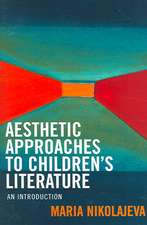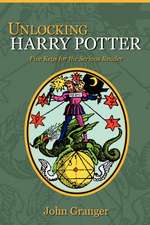Children's Literature: A Reader's History, from Aesop to Harry Potter
Autor Professor Seth Lereren Limba Engleză Paperback – sep 2009
Ever since children have learned to read, there has been children’s literature. Children’s Literature charts the makings of the Western literary imagination from Aesop’s fables to Mother Goose, from Alice's Adventures in Wonderland to Peter Pan, from Where the Wild Things Are to Harry Potter.
The only single-volume work to capture the rich and diverse history of children’s literature in its full panorama, this extraordinary book reveals why J. R. R. Tolkien, Dr. Seuss, Laura Ingalls Wilder, Beatrix Potter, and many others, despite their divergent styles and subject matter, have all resonated with generations of readers. Children’s Literature is an exhilarating quest across centuries, continents, and genres to discover how, and why, we first fall in love with the written word.
“Lerer has accomplished something magical. Unlike the many handbooks to children’s literature that synopsize, evaluate, or otherwise guide adults in the selection of materials for children, this work presents a true critical history of the genre. . . . Scholarly, erudite, and all but exhaustive, it is also entertaining and accessible. Lerer takes his subject seriously without making it dull.”—Library Journal (starred review)
“Lerer’s history reminds us of the wealth of literature written during the past 2,600 years. . . . With his vast and multidimensional knowledge of literature, he underscores the vital role it plays in forming a child’s imagination. We are made, he suggests, by the books we read.”—San Francisco Chronicle
“There are dazzling chapters on John Locke and Empire, and nonsense, and Darwin, but Lerer’s most interesting chapter focuses on girls’ fiction. . . . A brilliant series of readings.”—Diane Purkiss, Times Literary Supplement
The only single-volume work to capture the rich and diverse history of children’s literature in its full panorama, this extraordinary book reveals why J. R. R. Tolkien, Dr. Seuss, Laura Ingalls Wilder, Beatrix Potter, and many others, despite their divergent styles and subject matter, have all resonated with generations of readers. Children’s Literature is an exhilarating quest across centuries, continents, and genres to discover how, and why, we first fall in love with the written word.
“Lerer has accomplished something magical. Unlike the many handbooks to children’s literature that synopsize, evaluate, or otherwise guide adults in the selection of materials for children, this work presents a true critical history of the genre. . . . Scholarly, erudite, and all but exhaustive, it is also entertaining and accessible. Lerer takes his subject seriously without making it dull.”—Library Journal (starred review)
“Lerer’s history reminds us of the wealth of literature written during the past 2,600 years. . . . With his vast and multidimensional knowledge of literature, he underscores the vital role it plays in forming a child’s imagination. We are made, he suggests, by the books we read.”—San Francisco Chronicle
“There are dazzling chapters on John Locke and Empire, and nonsense, and Darwin, but Lerer’s most interesting chapter focuses on girls’ fiction. . . . A brilliant series of readings.”—Diane Purkiss, Times Literary Supplement
Preț: 141.34 lei
Nou
Puncte Express: 212
Preț estimativ în valută:
27.05€ • 28.08$ • 22.55£
27.05€ • 28.08$ • 22.55£
Carte disponibilă
Livrare economică 01-15 martie
Preluare comenzi: 021 569.72.76
Specificații
ISBN-13: 9780226473017
ISBN-10: 0226473015
Pagini: 400
Ilustrații: 24 halftones
Dimensiuni: 152 x 229 x 23 mm
Greutate: 0.55 kg
Editura: University of Chicago Press
Colecția University of Chicago Press
ISBN-10: 0226473015
Pagini: 400
Ilustrații: 24 halftones
Dimensiuni: 152 x 229 x 23 mm
Greutate: 0.55 kg
Editura: University of Chicago Press
Colecția University of Chicago Press
Notă biografică
Seth Lerer is dean of arts and humanities at the University of California, San Diego. He is the author of many books, including Inventing English: A Portable History of the Language, and the editor of several collections, including The Yale Companion to Chaucer.
Cuprins
List of Illustrations
Introduction Toward a New History of Children’s Literature
Chapter One Speak, Child: Children’s Literature in Classical Antiquity
Chapter Two Ingenuity and Authority: Aesop’s Fables and Their Afterlives
Chapter Three Court, Commerce, and Cloister: The Literatures of Medieval Childhood
Chapter Four From Alphabet to Elegy: The Puritan Impact on Children’s Literature
Chapter Five Playthings of the Mind: John Locke and Children’s Literature
Chapter Six Canoes and Cannibals: Robinson Crusoe and Its Legacies
Chapter Seven From Islands to Empires: Storytelling for a Boy’s World
Chapter Eight On beyond Darwin: From Kingsley to Seuss
Chapter Nine Ill-Tempered and Queer: Sense and Nonsense, from Victorian to Modern
Chapter Ten Straw into Gold: Fairy-Tale Philology
Chapter Eleven Theaters of Girlhood: Domesticity, Desire, and Performance in Female Fiction
Chapter Twelve Pan in the Garden: The Edwardian Turn in Children’s Literature
Chapter Thirteen Good Feeling: Prizes, Libraries, and the Institutions of American Children’s Literature
Chapter Fourteen Keeping Things Straight: Style and the Child
Chapter Fifteen Tap Your Pencil on the Paper: Children’s Literature in an Ironic Age
Epilogue Children’s Literature and the History of the Book
Acknowledgments
Notes
Index
Introduction Toward a New History of Children’s Literature
Chapter One Speak, Child: Children’s Literature in Classical Antiquity
Chapter Two Ingenuity and Authority: Aesop’s Fables and Their Afterlives
Chapter Three Court, Commerce, and Cloister: The Literatures of Medieval Childhood
Chapter Four From Alphabet to Elegy: The Puritan Impact on Children’s Literature
Chapter Five Playthings of the Mind: John Locke and Children’s Literature
Chapter Six Canoes and Cannibals: Robinson Crusoe and Its Legacies
Chapter Seven From Islands to Empires: Storytelling for a Boy’s World
Chapter Eight On beyond Darwin: From Kingsley to Seuss
Chapter Nine Ill-Tempered and Queer: Sense and Nonsense, from Victorian to Modern
Chapter Ten Straw into Gold: Fairy-Tale Philology
Chapter Eleven Theaters of Girlhood: Domesticity, Desire, and Performance in Female Fiction
Chapter Twelve Pan in the Garden: The Edwardian Turn in Children’s Literature
Chapter Thirteen Good Feeling: Prizes, Libraries, and the Institutions of American Children’s Literature
Chapter Fourteen Keeping Things Straight: Style and the Child
Chapter Fifteen Tap Your Pencil on the Paper: Children’s Literature in an Ironic Age
Epilogue Children’s Literature and the History of the Book
Acknowledgments
Notes
Index
Recenzii
“Lerer’s Olympian survey of more than 2,000 years leaves the reader with a stimulating vision of history. . . . His narrative swells and ebbs like a symphony. . . . To find Pilgrim's Progress and Weetzie Bat in a single volume is itself a pleasure.”
“Lerer has accomplished something magical. Unlike the many handbooks to children’s literature that synopsize, evaluate, or otherwise guide adults in the selection of materials for children, this work presents a true critical history of the genre. . . . Scholarly, erudite, and all but exhaustive, it is also entertaining and accessible. Lerer takes his subject seriously without making it dull.”
“Lerer’s history reminds us of the wealth of literature written during the past 2,600 years. . . . With his vast and multidimensional knowledge of literature, he underscores the vital role it plays in forming a child’s imagination. We are made, he suggests, by the books we read.”
“There is hardly a children’s classic, from Robinson Crusoe to Where the Wild Things Are to pop-up books, which [Lerer] does not discuss with sympathy and wit.”—Eric Ormsby, New York Sun
“There are dazzling chapters on John Locke and Empire, and nonsense, and Darwin, but Lerer’s most interesting chapter focuses on girls’ fiction. In a brilliant series of readings, he uncovers a preoccupation with theatricality in classic fiction for girls, from the melodramatic conduct of Anne of Green Gables to Jo March’s career as dramatist.”
“A history of children's literature is . . . a history of literature itself and Seth Lerer, by training a medieval philologist like J.R.R. Tolkien and C.S. Lewis, has written a very good one.”
“A dazzling cornucopia of erudition and originality on a subject of grave concern in twenty-first century U.S. education and culture. Every page of Seth Lerer’s brilliant book reminds us of the supreme and enduring value of childhood reading. This volume deserves the attention of all who care about the shaping of lives—educators on all levels, policy makers, psychologists, and parents, as well as scholars. Lerer writes that children's literature is meant ‘docere et delectare’ (to instruct and to delight), and this is precisely what he himself has done in this fascinating book.”
“A wonderful book, with remarkable temporal breadth in its vision of the children’s tradition. Highly effective as a work of synthesis, yet with many, many moments of originality and surprise, even for expert readers. Anyone engaged (whether as scholar, educator, even ‘simply’ as parent) with the psychic life of children will have much to learn from Lerer’s account.”
“A breathtakingly powerful and complex history of children’s literature that energizes rather than depletes. Lerer gives us the facts, but he also weaves experiences and stories into an account that moves in registers ranging from the ecstatic to the elegiac. An ideal guide for students new to the field of children’s literature as well as for scholars familiar with the territory.”
“Seth Lerer’s Children’s Literature: A Reader’s History from Aesop to Harry Potter is unique in its method, depth, and breadth. Lerer’s comprehensive knowledge of ancient and medieval literature serves him well, for he has a singular understanding of how vernacular literature originated and informed literature for children and adults and how children’s literature informed the construction of both childhood and adult readers. It is a joy to read his study because one can sense a serious and sensitive mind at work, seeking to chart a new path through the history of children’s literature. Lerer mixes his personal reading experience with an astute scholarly appreciation of literary reception, and the result is an original study that will contribute to a greater awareness of the profundity of children’s literature.”
"Splendidly well written, and both wide-ranging and comprehensive."
"It's a thick scholarly tome, but also a charming read that revels in children's imaginations and the timeless works that stimulate them. . . . The book's main attraction is its obvious delight in the subject matter: Lerer perfectly captures the love of literature that follows a voracious child reader into adulthood."
“Lerer makes some smart, timely arguments. Opening up a too-constricted definition of children’s literature is a crucial corrective;
anyone who studies children before the twentieth century already knows that children read and were influenced by far more than so-called children’s books. It is high time that children’s literary histories acknowledged and analyzed those materials.”
anyone who studies children before the twentieth century already knows that children read and were influenced by far more than so-called children’s books. It is high time that children’s literary histories acknowledged and analyzed those materials.”
"Lerer has so many unusual insights, and illuminating observations that anyone who loved reading as a child will find his book utterly absorbing."
"Children's Literature will make many people reconsider, re-evaluate, and perhaps re-engage with the body of writing that has been generated for the young over the centuries. . . . A well-written and entertaining book."











